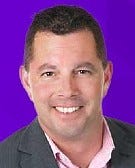N-able Empower 2022: MSPs Surviving and Thriving in Economic UncertaintyN-able Empower 2022: MSPs Surviving and Thriving in Economic Uncertainty
Cloud adoption represents a massive opportunity for MSPs.

N-ABLE EMPOWER 2022 — Empower 2022 by N-able kicked off Tuesday in Las Vegas with CEO John Pagliuca (pictured on stage above) telling MSPs how they can turn headwinds into tailwinds during upcoming economic uncertainty.
Empower 2022 is the first live N-able conference. In July 2021, SolarWinds completed its spinoff of N-able, which is now an independent, publicly traded company.
The theme of N-able Empower 2022 is “own the cloud.” The conference has attracted MSPs globally.
David Weeks is N-able’s senior director of partner experience.

N-able’s David Weeks
“‘Own the cloud’ is a mantra,” he said. “It’s where we’re moving. It brings opportunities and capabilities, all you can harness.”
Pagliuca told MSPs that while nothing is recession proof, MSPs are recession-resilient.
“There are some dark clouds at the moment,” he said. “We’re hearing about higher inflation and crazy fluctuations in capital value. Low interest rates? They’re over. In 2022, we’ve seen the highest increase in the cost of capital in the history of our country.”
Preparing for Economic Turbulence
Pagliuca said there are four things MSPs need to do to prepare for economic turbulence. The first is “hit the books.”
“Look at your financial records,” he said. “Understand your balance sheet, accounts receivable. Understand where your costs are. When capital gets expensive … make sure you know if your debt is fixed or variable interest rates … because that will put pressure on cash flow and your balance sheet.”
In addition, MSPs should think about securing more debt now, Pagliuca said.
“Make sure you have an extended line of credit in case your financial situation worsens,” he said. “Build that parachute now.”
Second, plan for 2023 and beyond, Pagliuca said.
“Failing to plan is planning to fail,” he said. “We’re in October 2022, and N-able is very much in planning season, making sure to understand how we’re going to grow our business. In a down cycle, figure how you’re going to grow your business. Build your plan, a contingency plan, and understand what customers are more susceptible to the downturn.”
Third, MSPs need to standardize and optimize, Pagliuca said.
“Certain things are out of your control, but certain things are absolutely in your control,” he said. “When the cost of money goes up, cash is king. See what can you do to drive more business. Standardize your service offerings. That makes teams more efficient and drives bottom line.”
Lastly, MSPs need to be an expert, not a commodity, to their customers, Pagliuca said.
“See what can you do now to let customers know you are their strategic partner … what can you do to bring down their costs, move capex,” he said.
A Raincoat in the Financial Storm
These are the steps to bring a raincoat into the financial storm, Pagliuca said.
“If you do the right steps, you’ll come out of this stronger, more profitable, and gain market share and expansion,” he said. “Turn headwinds into tailwinds.”
Cloud adoption represents a massive opportunity for MSPs, Pagliuca said. By 2027, SME businesses will spend $1 trillion in the cloud.
“That’s the opportunity,” he said. “Who’s going to bring it to them? Some are going on their own. The opportunity is in front of you, and you need to be deliberate and explicit. Understand where the adoption is, what’s going on with the customer environment, and lean in with adoption.”
With the ongoing labor shortage, automation is a “force multiplier,” Pagliuca said.
“A lot of MSPs are not embracing our total suite to automate,” he said. “We need to do more to bring that to the front. Another advantage of automating is standardizing services you’re delivering to customers. Make sure you’re not losing customers.”
More MSPs need to embrace the enterprise, Pagliuca said. When SolarWinds started, MSPs were servicing small companies. Now there are MSPs serving Fortune 500 companies with household names.
Big companies are also struggling with the labor shortage, he said.
“There’s an opportunity for you to sell up-market,” Pagliuca said. “You can double or triple selling price with stickier, bigger customers. There’s higher revenue, and if you’re in the market to potentially sell your business, your quality of earnings will be higher.”
Want to contact the author directly about this story? Have ideas for a follow-up article? Email Edward Gately or connect with him on LinkedIn. |
Read more about:
MSPsAbout the Author
You May Also Like


